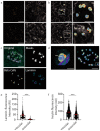Machine Learning Algorithms, Applied to Intact Islets of Langerhans, Demonstrate Significantly Enhanced Insulin Staining at the Capillary Interface of Human Pancreatic β Cells
- PMID: 34200432
- PMCID: PMC8229564
- DOI: 10.3390/metabo11060363
Machine Learning Algorithms, Applied to Intact Islets of Langerhans, Demonstrate Significantly Enhanced Insulin Staining at the Capillary Interface of Human Pancreatic β Cells
Abstract
Pancreatic β cells secrete the hormone insulin into the bloodstream and are critical in the control of blood glucose concentrations. β cells are clustered in the micro-organs of the islets of Langerhans, which have a rich capillary network. Recent work has highlighted the intimate spatial connections between β cells and these capillaries, which lead to the targeting of insulin secretion to the region where the β cells contact the capillary basement membrane. In addition, β cells orientate with respect to the capillary contact point and many proteins are differentially distributed at the capillary interface compared with the rest of the cell. Here, we set out to develop an automated image analysis approach to identify individual β cells within intact islets and to determine if the distribution of insulin across the cells was polarised. Our results show that a U-Net machine learning algorithm correctly identified β cells and their orientation with respect to the capillaries. Using this information, we then quantified insulin distribution across the β cells to show enrichment at the capillary interface. We conclude that machine learning is a useful analytical tool to interrogate large image datasets and analyse sub-cellular organisation.
Keywords: automation; beta cell; cell segmentation; deep learning; human; insulin; islet; machine learning; polarisation.
Conflict of interest statement
The authors declare no conflict of interest.
Figures








Similar articles
-
Pancreatic Pericytes in Glucose Homeostasis and Diabetes.Adv Exp Med Biol. 2019;1122:27-40. doi: 10.1007/978-3-030-11093-2_2. Adv Exp Med Biol. 2019. PMID: 30937861 Review.
-
[Impact of islet alpha cell loss on insulin secretion].Zhonghua Yi Xue Za Zhi. 2002 Oct 25;82(20):1427-31. Zhonghua Yi Xue Za Zhi. 2002. PMID: 12509929 Chinese.
-
The Role of the Islet Niche on Beta Cell Structure and Function.J Mol Biol. 2020 Mar 6;432(5):1407-1418. doi: 10.1016/j.jmb.2019.10.032. Epub 2019 Nov 9. J Mol Biol. 2020. PMID: 31711959 Review.
-
Orientation of microvascular blood flow in pancreatic islet isografts.J Clin Invest. 1994 May;93(5):2280-5. doi: 10.1172/JCI117228. J Clin Invest. 1994. PMID: 8182162 Free PMC article.
-
Local Integrin Activation in Pancreatic β Cells Targets Insulin Secretion to the Vasculature.Cell Rep. 2018 Sep 11;24(11):2819-2826.e3. doi: 10.1016/j.celrep.2018.08.035. Cell Rep. 2018. PMID: 30208309
Cited by
-
High-throughput image analysis with deep learning captures heterogeneity and spatial relationships after kidney injury.Sci Rep. 2023 Apr 19;13(1):6361. doi: 10.1038/s41598-023-33433-3. Sci Rep. 2023. PMID: 37076596 Free PMC article.
-
Islet Biology and Metabolism.Metabolites. 2021 Nov 18;11(11):786. doi: 10.3390/metabo11110786. Metabolites. 2021. PMID: 34822444 Free PMC article.
References
Grants and funding
LinkOut - more resources
Full Text Sources

